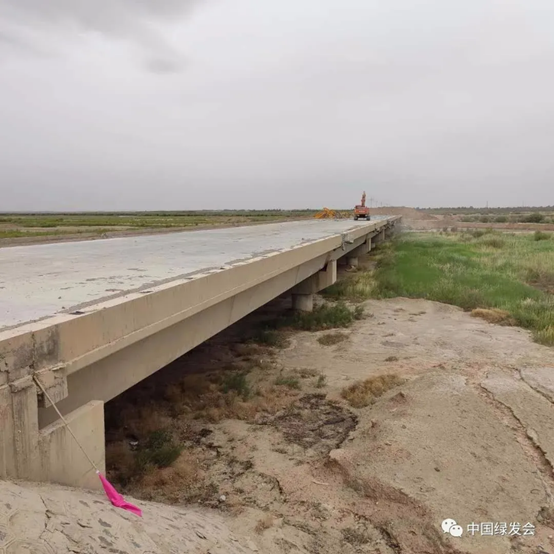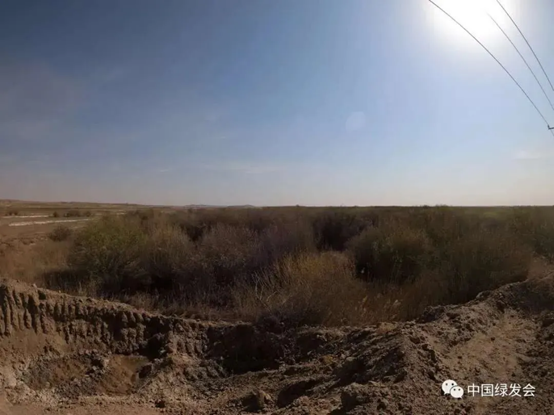The Environmental Public Interest Litigation (EPIL) case of China Biodiversity Conservation and Green Development Foundation (CBCGDF)’s suing Minqin County Rongda Mining Co., Ltd. for illegal bridge construction and damage to the Shiyang River National Wetland Park was formally accepted by the Gansu Mining District People’s Court on January 19.
This incident has the latest development: the bridge was recently demolished by the company!
The media immediately contacted Liu Yong, the legal representative of Minqin County Rongda Mining Co., Ltd. Liu Yong confirmed this: "We have completely demolished this bridge lately according to the requirements of the Minqin County Government."
Later, the media contacted the local villagers and confirmed that the illegally constructed bridge had been completely demolished around mid-June. The villagers said that the bridge did bring convenience to the masses, but now it has been demolished, which makes people feel very surprised.
In fact, similar things are not isolated cases - when a construction project is found to be unlawful and compliant, incomplete in policies or procedures, and environmentally affected, it is required to be completely demolished after it has been completed. An illegal construction may have an impact on the ecological environment, and a demolition project may also have an impact. So, for the desert reservoir bridge that has been built, is demolishing it the most effective measure to eliminate the major risks to the ecological environment caused by it? What effective measures should be taken to eliminate the major risks to the ecological environment caused by an illegally built bridge? What measures should be taken to eliminate the impact, and who should listen to?
Focus one
Construct illegally built transportation bridge in Shiyanghe National Wetland Park
Ma Yong, Deputy Secretary-General of CBCGDF, said that in November 2019, CBCGDF received report from volunteers, in the upper reaches of the Hongyashan Reservoir in Minqin County, Wuwei City, Gansu Province, the Shiyang River Basin enters the lower reaches of the confluence of the reservoir, located about 1.8 kilometers east of Minqin County Rongda Mining Co., Ltd., a 260-meter-long bridge had been built and put into use.
It is understood that this bridge was built by Minqin County Rongda Mining Co., Ltd. as a special line for enterprise production and transportation. CBCGDF applied to the Minqin County Government for government information disclosure and obtained the Minqin Sub-bureau of the Wuwei City Ecological Environment Bureau replied that the project had not fulfilled the environmental impact assessment and approval procedures.
An enterprise mainly engaged in manufacturing, mining, production and sales of chemical raw materials, and foreign investment, in order to facilitate the transportation of the production materials and products of the project, needs to build a Hongyashan Reservoir Bridge on the south side of the Hongyashan Reservoir. In an area where the ecological conditions are very sensitive, the procedures for environmental impact assessment and approval had not been fulfilled. Similarly, biodiversity surveys, assessments and monitoring had not been carried out.
The "Letter on the Design Scheme of the Hongyashan Reservoir Bridge in Rongda Mining, Minqin County" obtained by the media issued by the Northwest Branch of Anhui Provincial Transportation Planning and Design Research Institute Co., Ltd. shows that Minqin County Rongda Mining Co., Ltd. stated that the survey and design was undertaken by the Northwest Branch of Anhui Transportation Planning and Design Research Institute Co., Ltd. However, the actual situation is: "However, in the follow-up contract, we conducted surveys and submitted the measurement drawings. Because Minqin County Rongda Mining Co., Ltd. did not perform the agreed obligation to pay the project advance payment in the follow-up contract, we did not provide them with design documents and construction drawings." That is to say, the bridge had not been approved by the government, especially without the approval of the environmental impact assessment, the approval of the soil and water conservation plan, and the construction permit, directly based on the construction drawing design documents of other bridge projects, Minqin County Rongda Mining Co., Ltd. built the bridge in Shiyanghe National Wetland Park by itself.
Focus two
To eliminate the impact of illegal projects on the ecology of the area, is it the end of the demolition done?
What impact does a bridge have on the environment? Downstream of this bridge is the Hongyashan Reservoir, known as "Asia's largest desert reservoir". It has very important ecological functions. It is the only water conservancy storage project in Minqin County, irrigating more than 600,000 mu of arable land of the county. Moreover, around the reservoir, there are national first-class protected animals ern and Mergus squamatus, and second-class national protected animals whooper swan, white spoonbill, grey crane and other birds inhabit.
Ma Yong introduced that Minqin County Rongda Mining Co., Ltd. illegally built the bridge as a channel for production and transportation without conducting an environmental impact assessment. The construction and operation of the bridge will have adverse effects such as disturbing the migratory birds inhabiting the surrounding area, resulting in the destruction of the migratory bird habitat there. During the construction of the bridge, the excavation of the river course will cause damage to the river bed and embankment, bridge abutment and slope protection, because the vegetation coverage in this area is relatively low, and the hydrophysical conditions of the underlying surface are poor, which easily leads to soil erosion. At the same time, the construction of the bridge has reduced the cross-section of the original river bed, which may have a serious impact on the flood control and flood discharge of Hongya Mountain. Minqin County Rongda Mining Co., Ltd. used the bridge to transport the chemical raw materials products involved in calcium carbide and other chemical raw materials, which may be spilled or leaked, or if an accident occurs, it will cause major pollution to the water body of the Hongyashan Reservoir.
CBCGDF filed the following litigation request: “Order the defendant to take effective measures immediately to eliminate the major risks to the ecological environment caused by illegal bridge construction; Order the defendant to take immediate measures to repair the ecological damage caused by its illegal bridge construction or bear the repair costs..."
Minqin County Rongda Mining Co., Ltd.'s illegal construction of bridges has attracted great attention after being sued by the CBCGDF.
A meeting minutes of the Minqin County People’s Government obtained by the media showed that the meeting agreed that: “The Hongyashan Reservoir Bridge built by Minqin County Rongda Mining Co., Ltd. in 2013, because there is no environmental impact assessment procedure and it does not meet the relevant norms and requirements for flood control, according to the "People's Republic of China Flood Control Law", "Regulations of the People's Republic of China on River Management" "Environmental Impact Assessment Law of the People's Republic of China" and other laws and regulations, and the county government’s ‘Minutes of the County Mayor’s Office Meeting’ on the Minqin County Rongda Mining Co., Ltd. Hongyashan Reservoir Bridge problem rectification on May 16, 2020, needs to be demolished. "
After CBCGDF sued the private company that built the bridge, the government ordered the company to demolish the bridge.
After learning that the company was demolishing the bridge, the CBCGDF immediately proposed to the court to stop demolishing the bridge immediately.
Then everyone doesn't understand-you said that this bridge destroys the ecological environment, wouldn't it be fine if it was demolished?
Zhou Jinfeng, the Secretary-General of CBCGDF said that whether to demolish the bridge should be re-evaluated; how to demolish it also needs to be re-evaluated.
In Zhou Jinfeng's view, without a corresponding environmental impact assessment, it is undoubtedly wrong to violate regulations and build bridges in ecologically sensitive areas. However, if you want to correct and make up for this error through demolition, you should make serious assessments just like when you made mistakes, and carry out biodiversity surveys, assessments, monitoring, compensation and adaptation. The demolition project should not cause a second damage to the ecological environment.
The illegally built bridge was completely demolished in the debate about whether to demolish. However, the ecological damage already caused by illegal construction of the bridge and the damage to the ecological environment will not disappear because of the disappearance of this bridge.
An ecological expert interviewed by the media said that whether the bridge should be demolished should be subject to a scientific evaluation by a professional organization before making a decision on demolishing or not based on the evaluation results. Because this bridge has been built for some time, it has formed a new natural landform and habitat state. Under this circumstance, what is the impact of bridge demolition on the new ecological environment? Although most of the effects may be benign, evaluation should also be carried out.


(Photo credit: CBCGDF volunteer)
Original Chinese article:
https://mp.weixin.qq.com/s/0LN14KcayId7Y-7fyD-YRw
By / Zhang Daqian Modified / Maggie
https://www.paypal.me/CBCGDFChina
http://www.cbcgdf.org/English/ConfirmDonaTion/0.html


(Please indicate "I read CBCGDF" in the payment notes, thank you!)
